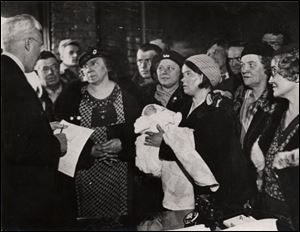
Area residents had hope in '38, and we should now
12/23/2008We'll make it through this Christmas, for sure. But everywhere are signs of real need. Unemployment is high, the economy is depressed, many businesses have failed, plants have closed, and layoffs are widespread. Yet there is hope for the new year.
This is not unlike the dismal but hope-filled Christmas of 1938, 70 years ago during the Great Depression. Toledoans have been here before.
By that Christmas, the city and the country had been through a tough nine years since the stock-market crash of 1929, but things were starting to turn around. Business was recovering, jobs were more available, stocks were climbing out of a terrible bear market.
Here we are at the end of 2008, wondering if the latest bear market has bottomed out, wondering if the unemployment rate will hit double digits nationally (as it has in recent measures locally), and wondering if good times will begin to return next year.

By the late 30s, nearly half the city s residents had been helped by the WPA.
Perhaps it was easier to be hopeful in 1938, because the economy had fallen so far in the early 1930s that it could only go up from there.
By July of 1932, the Dow Jones industrial average had dropped to just 41.22, a full 89 percent below its peak in 1929 just before the crash. The Dow recovered nicely by 1937, but was still far below its pre-crash level, when another vicious bear market took stock values down 49 percent by early 1938.
Even so, stocks looked relatively good in late 1938 and were up more than 50 percent from the bottom.
Employment looked better, too. In the depths of the Depression, 1932, the nation's unemployment rate hit
25 percent, and Toledo's was far worse - some estimates were as high as 44 percent.
But by the late 1930s, nearly half of the city's 284,000 residents had received some help from the government's Works Progress Administration. The WPA employed 51,000 from the Toledo area to construct public buildings, highways, bridges, parks, and sewer systems.
In addition, some 30,000 to 40,000 Toledo families were on the city's relief rolls in the worst of the Depression. Churches and charities did their part, as did neighborhood groups, women's clubs, the Old Newsboys, the Junior League, schools, unions, and fraternal organizations.
The Blade ran front-page stories almost daily in the weeks leading up to the Christmas of 1938 asking for contributions for food baskets and dinners for the needy. On Christmas Eve that year, the Salvation Army, with help from the funds raised by The Blade and the Paramount Theater, distributed 1,250 food baskets.
At the end of 1938, economic indicators were looking up. On Jan. 2, 1939, a Blade editorial noted that "expectation of a good 1939 is not based entirely upon wishful thinking. Evidence of a better day, while not of landslide proportions, is obviously at hand. The business outlook is definitely better than it was a few months ago."
War was looming in Europe, and World War II began in 1939. The war eventually would lift the United States out of its economic doldrums - at great cost in dollars and lives.
If there could be hope at the end of 1938, after the turmoil of the Great Depression, surely there is hope at the end of 2008.